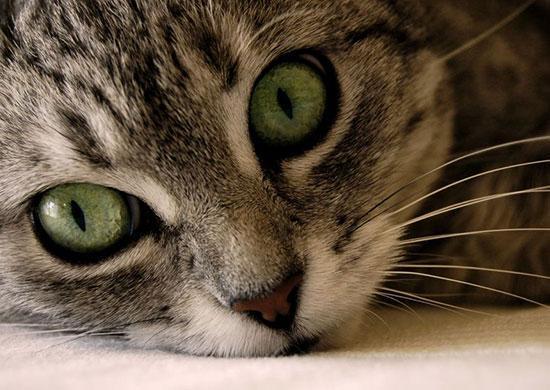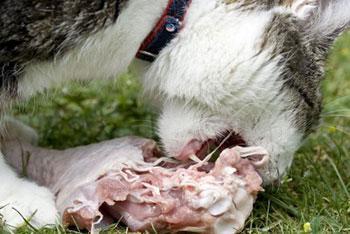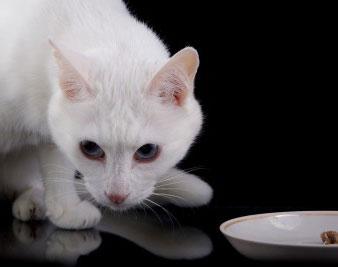This content is archived from the Feline Nutrition Foundation
Chunks and Bones For Your Cat's Teeth
- Updated: Friday, May 24, 2019 02:20 PM
- Published: Wednesday, October 05, 2011 01:04 PM
- Written by Guillermo Díaz. MV
 Knowing that chewing on meat chunks and small pieces with bones, such as chicken wings, are "nature's toothbrush" for cats, I want my cat to eat these to help clean her teeth. But, she refuses to eat meat chunks no matter what I try. Someone told me this could be because her teeth hurt. She has some tartar on her teeth. Could this be why she won't eat chunks?
Knowing that chewing on meat chunks and small pieces with bones, such as chicken wings, are "nature's toothbrush" for cats, I want my cat to eat these to help clean her teeth. But, she refuses to eat meat chunks no matter what I try. Someone told me this could be because her teeth hurt. She has some tartar on her teeth. Could this be why she won't eat chunks?
Domestic cats are obligate carnivores. They evolved to hunt, ingest and efficiently digest small prey. They have developed very specific taste and scent capabilities that prevent them from consuming anything that is not fresh. In the wild, they would eat many small-volume meals during a 24 hour day, around 10 to 20 on average, many just a bite or two. Let's grab a tiny mouse in our hands and if we are keen observers, we'll discover the features that make it so appealing to a cat:
- Each mouse weighs between 20 to 40 grams or .7 to 1.4 ounces, very small chunks.
- They are warm, about 39°C or 102°F.
- They smell good: blood and flesh odor produced by volatile fatty acids of the prey.
- They are juicy, about 75% water content.
What can we infer from all of this? When feeding an indoor cat, we should try to re-create the whole prey our cat would be eating in the wild. If your cat doesn't want to eat the food presented to her, you should check to see if some of these features are missing. We need to remember that no man-made diet can hope to compare to fresh, natural, whole food. But, if this fresh food is unfamiliar to your cat, she may not take to it right away or won't eat it at all.
 There could be more than one reason why a cat refuses to eat meat chunks and raw meaty bones. Let's take a look at some of the possibilities.
There could be more than one reason why a cat refuses to eat meat chunks and raw meaty bones. Let's take a look at some of the possibilities.
Characteristics of meat itself:
- Size and shape
- Temperature
- Taste and smell
- Consistency
Pertaining to the cat:
- Habit and neophobia
- Dental problems
The best size, shape and temperature of the meat can be determined with some experimentation to see what your cat prefers. Taste, smell and consistency will vary with the kind of meat you choose, and your cat may have preferred types.
Habit and neophobia are two terms that go together when it comes to changing the diet of a cat. Habit would be what a cat is used to eating. That is, what she likes, but not necessarily what is healthiest for her, such as dry kibble or cooked bones. Neophobia is an aversion to the new and is very common amongst cats, meaning that a cat won't eat a new food presented to her. A cat's eating habits in her first few months of life play a big part in this. She will tend to eat and accept those meals she was presented as a kitten.
 Dental disease is one of the main reasons a cat may be reluctant to eat. It starts with plaque accumulation on the surface of the teeth, which then turns into tartar. This traps oral bacteria at the gum line, causing bad breath. The trapped bacteria multiply and produce toxins that can lead to painful infections, loosening of the attachments of gums to teeth, bone loss and eventual tooth loss. Even worse, these toxins don't remain only inside the mouth of the cat. They can enter the bloodstream and travel throughout the body, damaging the lungs, liver, kidneys and the valves of the heart.¹ Kidney damage leads to renal insufficiency, which can lead to death.
Dental disease is one of the main reasons a cat may be reluctant to eat. It starts with plaque accumulation on the surface of the teeth, which then turns into tartar. This traps oral bacteria at the gum line, causing bad breath. The trapped bacteria multiply and produce toxins that can lead to painful infections, loosening of the attachments of gums to teeth, bone loss and eventual tooth loss. Even worse, these toxins don't remain only inside the mouth of the cat. They can enter the bloodstream and travel throughout the body, damaging the lungs, liver, kidneys and the valves of the heart.¹ Kidney damage leads to renal insufficiency, which can lead to death.
Most oral pain in cats is the result of long-standing infection, fractured teeth with exposed pulp or the presence of resorptive lesions in their teeth. If a cat with dental problems is presented with a new food such as meat chunks and experiences pain during chewing, then this kitty will probably never be willing to eat this kind of food again.
I recommend looking inside your cat's mouth to check for any tartar, or have your vet check your kitty's teeth. Once tartar is present, chewing meat chunks or raw meaty bones is unlikely to remove it. Take your kitty to the vet for a dental checkup and cleaning. Once your cat's teeth are cleaned and you know she is not experiencing any dental pain, then introduce the new, whole foods. Any aversion at this point will be for other reasons, not because of dental problems.
Additional Reading
Answers: Raw Food for Cats, What About Eating Bones?
Answers: Kittens Go Through Teething, Too
Cats who chew raw bones must work their jaws to gnaw the meat and marrow from the bone, creating a natural toothbrush and tooth polisher that help keep your cats' teeth clean.² Cats who consume raw meaty bones daily usually have white teeth, healthy pink gums and fresh-smelling breath. Raw bones appropriate for cats include fresh chicken necks and wings, which the cat can completely consume. Never cook bones, even in the microwave, as cooking can make them more likely to splinter.
Note: Feline Nutrition provides feline health and nutrition information as a public service. Diagnosis and treatment of specific conditions should always be in consultation with your own veterinarian. Feline Nutrition disclaims all warranties and liability related to the veterinary advice and information provided on this site.
Dr. Guillermo Díaz and family, including their four dogs (Leroy, Xica, Moza and Pepa) and six cats (Michalina, Tigger, Vladimir, Yellow, Mongo and Chirusa) moved to Buenos Aires, Argentina in July of 2017, where he expects to continue supporting different animal rescue groups, spread the benefits of raw food for cats and dogs and write articles about nutrition.
1. David A. Fagan, DDS, Dental Consultant and Mark S. Edwards, PhD, Nutritionist, "Influence of Diet Consistency on Periodontal Disease in Captive Carnivores," The Colyer Institute, 2009.
2. Fagan, et al, "Influence of Diet Consistency on Periodontal Disease in Captive Carnivores."




